Acura RL 2001 3.5 Owner's Manual
Manufacturer: ACURA, Model Year: 2001, Model line: RL, Model: Acura RL 2001Pages: 333, PDF Size: 4.28 MB
Page 191 of 333
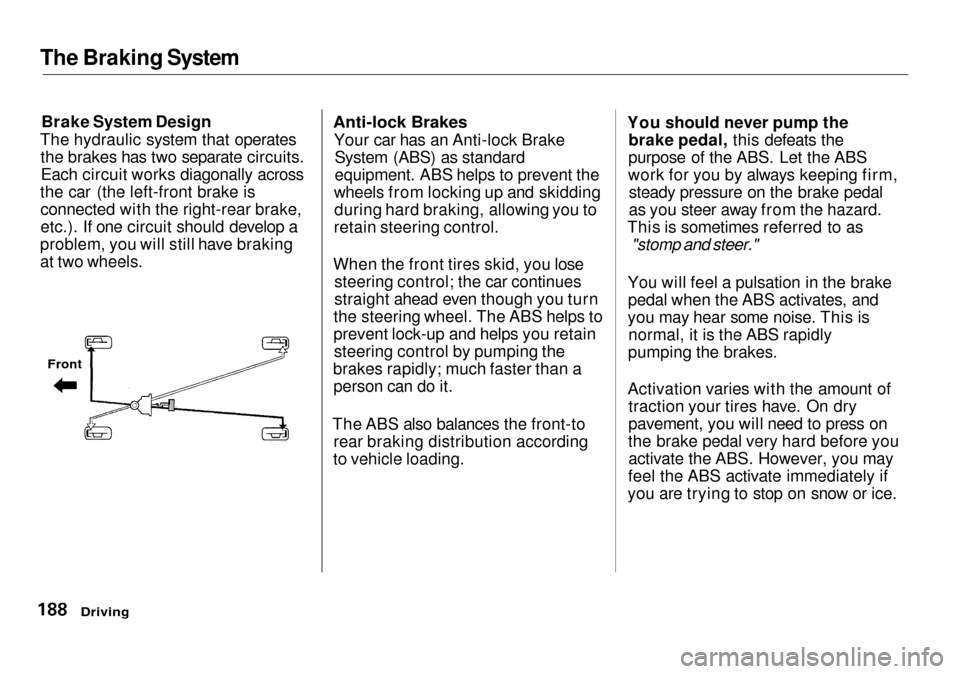
The Braking System
Brake System Design
The hydraulic system that operates the brakes has two separate circuits.Each circuit works diagonally across
the car (the left-front brake is connected with the right-rear brake,
etc.). If one circuit should develop a
problem, you will still have braking
at two wheels.
Front
Anti-lock Brakes
Your car has an Anti-lock BrakeSystem (ABS) as standard
equipment. ABS helps to prevent the
wheels from locking up and skidding during hard braking, allowing you to
retain steering control.
When the front tires skid, you lose steering control; the car continues
straight ahead even though you turn
the steering wheel. The ABS helps to
prevent lock-up and helps you retain steering control by pumping the
brakes rapidly; much faster than a person can do it.
The ABS also balances the front-to rear braking distribution according
to vehicle loading. You should never pump the
brake pedal, this defeats the
purpose of the ABS. Let the ABS
work for you by always keeping firm, steady pressure on the brake pedal
as you steer away from the hazard.
This is sometimes referred to as
"stomp and steer."
You will feel a pulsation in the brake pedal when the ABS activates, and
you may hear some noise. This is normal, it is the ABS rapidly
pumping the brakes.
Activation varies with the amount of traction your tires have. On dry
pavement, you will need to press on
the brake pedal very hard before you activate the ABS. However, you may
feel the ABS activate immediately if
you are trying to stop on snow or ice.
Driving
Page 192 of 333

The Braking System
Important Safety Reminders
ABS does not reduce the time or distance it takes to stop the car, it
only helps with steering controlduring braking. You should always
maintain a safe following distance
from other vehicles.
ABS will not prevent a skid that results from changing direction
abruptly, such as trying to take a corner too fast or making a sudden
lane change. Always drive at a safe,
prudent speed for the road and
weather conditions.
ABS cannot prevent a loss of stability. Always steer moderately
when you are braking hard. Severe or sharp steering wheel movement
can still cause your car to veer into
oncoming traffic or off the road. A vehicle with ABS may require a
longer distance to stop on loose or
uneven surfaces, such as gravel or snow, than a vehicle without anti-
lock. Slow down and allow a greater distance between vehicles under
those conditions.
ABS Indicator
U.S. indicator shown
The ABS is self-checking. If anything goes wrong, the ABS indicator on
the instrument panel comes on (see page 56 ). This means the anti-lock function of the braking system has
shut down. The brakes still work like
a conventional system without anti-
lock, providing normal stopping ability. You should have the dealer
inspect your car as soon as possible
if this light stays on after you start
the engine, or comes on whiledriving.
DrivingCONTINUED
ABS INDICATOR*
Page 193 of 333

The Braking System
If the ABS indicator and the brake
system indicator come on together,
and the parking brake is fully
released, the front-to-rear braking distribution system may also shut
down.
Test your brakes as instructed on page 289 . If the brakes feel normal,drive slowly and have your car
repaired by your dealer as soon as
possible. Avoid sudden hard braking
which could cause the rear wheels to lock up and possibly lead to a loss of
control.
The VSA system indicator may come on along with the ABS indicator if
there is a problem with the anti-lock
brake system.
Driving
Page 194 of 333
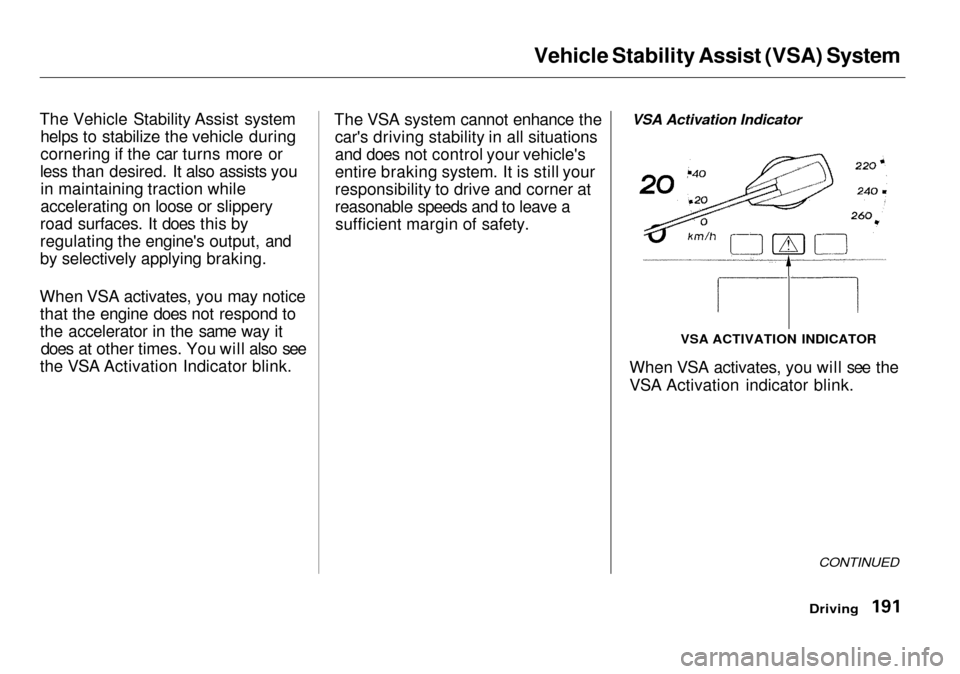
Vehicle Stability Assist (VSA) System
The Vehicle Stability Assist system helps to stabilize the vehicle during
cornering if the car turns more or
less than desired. It also assists you in maintaining traction while
accelerating on loose or slippery
road surfaces. It does this by
regulating the engine's output, and
by selectively applying braking.
When VSA activates, you may notice that the engine does not respond to
the accelerator in the same way it does at other times. You will also see
the VSA Activation Indicator blink. The VSA system cannot enhance the
car's driving stability in all situations
and does not control your vehicle's
entire braking system. It is still your
responsibility to drive and corner at
reasonable speeds and to leave asufficient margin of safety. VSA Activation Indicator
When VSA activates, you will see the
VSA Activation indicator blink.
Driving
CONTINUED
VSA ACTIVATION INDICATOR
Page 195 of 333

Vehicle Stability Assist (VSA) System
VSA System Indicator
The VSA system indicator (see page 56 ) comes on and stays on when
there is a problem with the VSA
system.
If the VSA indicator comes on while
driving, pull to the side of the road
when it is safe and turn off the engine. Reset the system by
restarting the engine, and watch the
VSA system indicator. If the indicator remains on, or comes backon while driving, have the VSA
system inspected by your Acura
dealer.
If the indicator does not come on
when the ignition switch is turned ON (II), there may be a problem
with the VSA system. Have your dealer inspect your car as soon as
possible.
Without VSA, your car will have normal braking and cornering ability,
but it will not have VSA traction andstability enhancement. VSA Off Switch
This switch is under the left vent. Press it to turn the Vehicle Stability
Assist system on and off.
When VSA is off, the VSA Activation Indicator light comes on as a
reminder. Pressing the switch again
turns the system back on.
Driving
VSA SYSTEM INDICATOR
Page 196 of 333

Vehicle Stability Assist (VSA) System
VSA is turned on every time you start the engine, even if you turned it
off the last time you drove the car. VSA and Tire Sizes
Driving with varying tire or wheel
sizes may cause the VSA to
malfunction. When replacing tires,
make sure they are of the same size
and type as your original tires (see
page 247).
Deactivate the VSA system if you
need to drive with the compact spare
tire installed (see page 272 ).
If you install winter tires, make sure
they are the same size as those that
were originally supplied with your car. Exercise the same caution
during winter driving as you would if
your car was not equipped with VSA.
Driving
Page 197 of 333
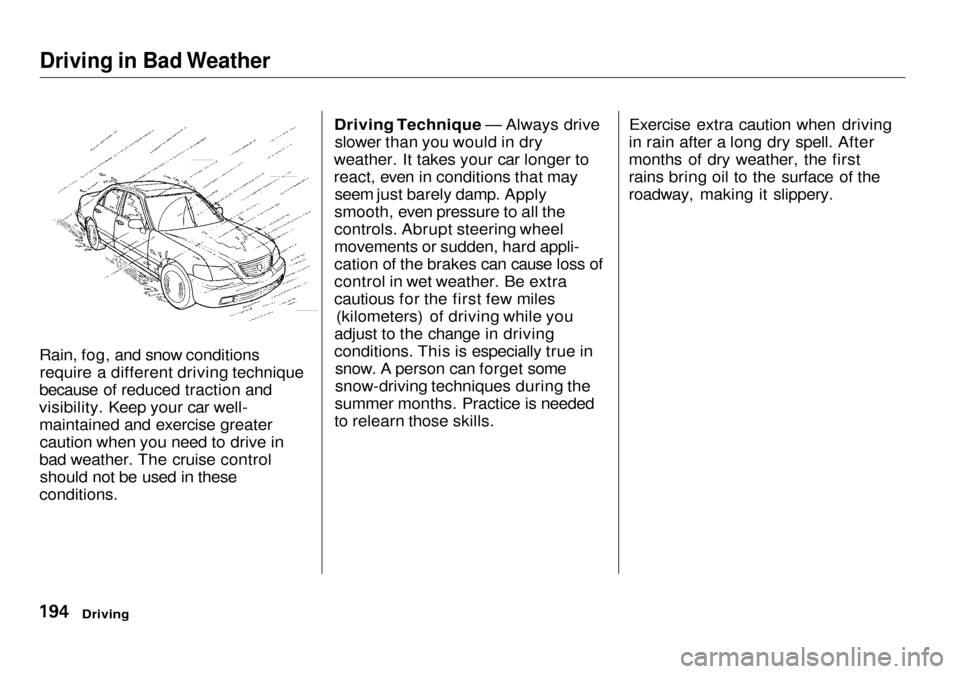
Driving in Bad Weather
Rain, fog, and snow conditions require a different driving technique
because of reduced traction and
visibility. Keep your car well- maintained and exercise greatercaution when you need to drive in
bad weather. The cruise control should not be used in these
conditions. Driving Technique — Always drive
slower than you would in dry
weather. It takes your car longer to
react, even in conditions that may seem just barely damp. Apply
smooth, even pressure to all the
controls. Abrupt steering wheel
movements or sudden, hard appli-
cation of the brakes can cause loss of
control in wet weather. Be extra
cautious for the first few miles (kilometers) of driving while you
adjust to the change in driving
conditions. This is especially true in snow. A person can forget some
snow-driving techniques during the
summer months. Practice is needed
to relearn those skills. Exercise extra caution when driving
in rain after a long dry spell. After
months of dry weather, the first
rains bring oil to the surface of the
roadway, making it slippery.
Driving
Page 198 of 333
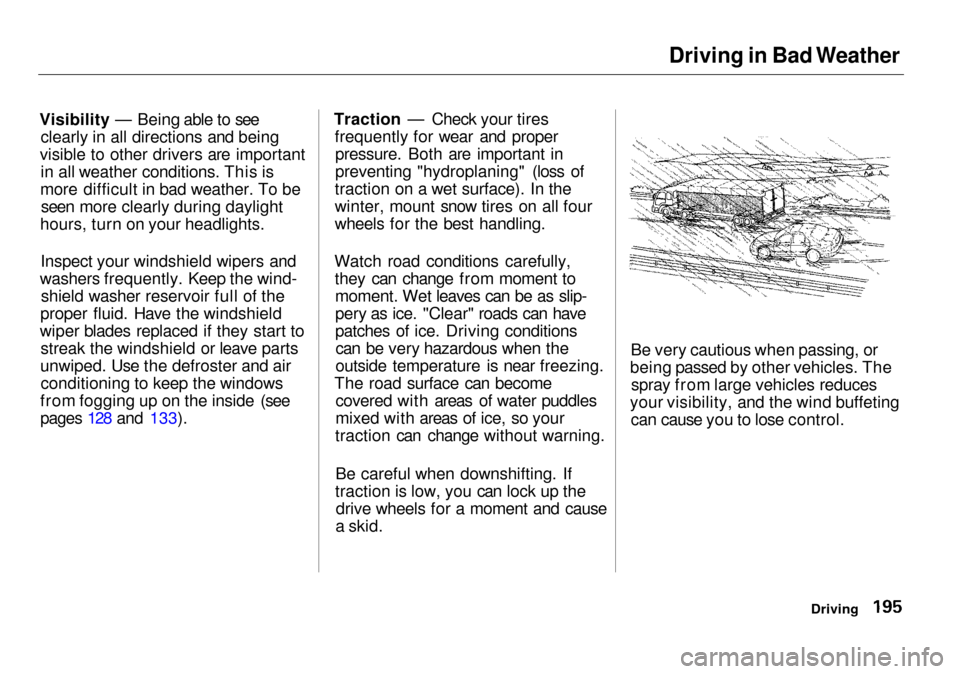
Driving in Bad Weather
Visibility — Being able to see clearly in all directions and being
visible to other drivers are important in all weather conditions. This is
more difficult in bad weather. To be seen more clearly during daylight
hours, turn on your headlights.
Inspect your windshield wipers and
washers frequently. Keep the wind- shield washer reservoir full of the
proper fluid. Have the windshield
wiper blades replaced if they start to streak the windshield or leave parts
unwiped. Use the defroster and air conditioning to keep the windows
from fogging up on the inside (see
pages 128 and 133). Traction — Check your tires
frequently for wear and properpressure. Both are important in
preventing "hydroplaning" (loss of
traction on a wet surface). In the
winter, mount snow tires on all four
wheels for the best handling.
Watch road conditions carefully, they can change from moment tomoment. Wet leaves can be as slip-
pery as ice. "Clear" roads can have
patches of ice. Driving conditionscan be very hazardous when the
outside temperature is near freezing.
The road surface can become covered with areas of water puddles
mixed with areas of ice, so your
traction can change without warning.
Be careful when downshifting. If
traction is low, you can lock up the drive wheels for a moment and cause
a skid. Be very cautious when passing, or
being passed by other vehicles. The spray from large vehicles reduces
your visibility, and the wind buffeting can cause you to lose control.
Driving
Page 199 of 333
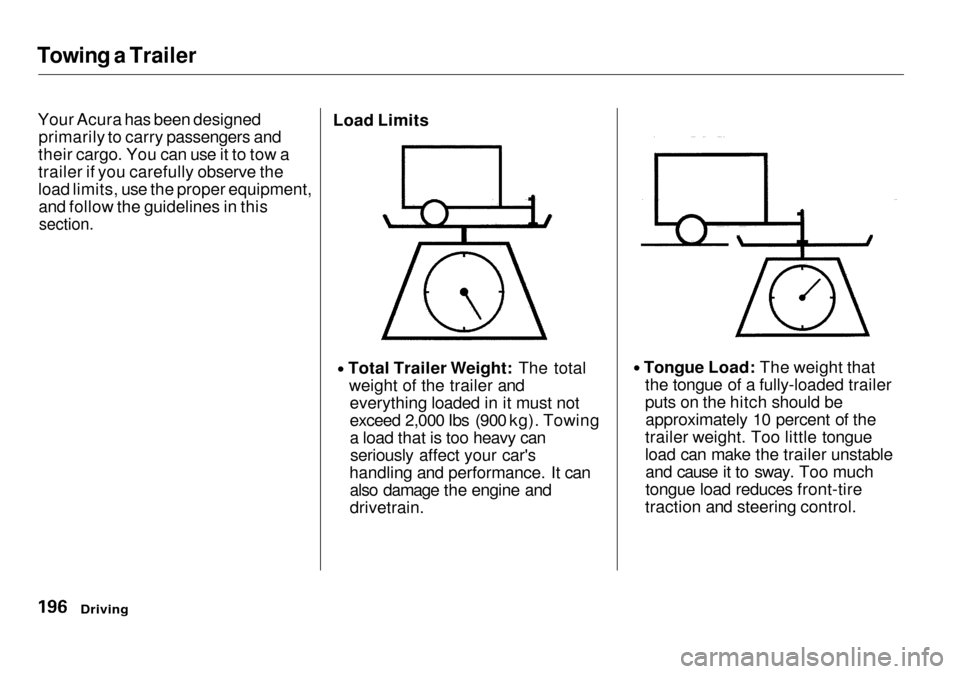
Towing a Trailer
Your Acura has been designedprimarily to carry passengers and
their cargo. You can use it to tow a
trailer if you carefully observe the
load limits, use the proper equipment, and follow the guidelines in this
section.
Load Limits
Total Trailer Weight: The totalweight of the trailer andeverything loaded in it must not
exceed 2,000 Ibs (900 kg). Towing
a load that is too heavy canseriously affect your car's
handling and performance. It can also damage the engine and
drivetrain. Tongue Load: The weight that
the tongue of a fully-loaded trailer
puts on the hitch should beapproximately 10 percent of the
trailer weight. Too little tongue
load can make the trailer unstable and cause it to sway. Too much
tongue load reduces front-tire
traction and steering control.
Driving
Page 200 of 333

Towing a Trailer
To achieve a proper tongue load, start by loading 60 percent of the
load toward the front of the trailer and 40 percent toward the rear, then
re-adjust the load as needed.
Gross Vehicle Weight Rating
(GVWR):
The total weight of the vehicle, all occupants, all cargo, and the
tongue load must not exceed:
4,830 Ibs (2,190 kg)
Gross Axle Weight Rating
(GAWR):
The total weight of the vehicle, all occupants, all cargo, and the
tongue load must not exceed:
2,570 Ibs (1,165 kg)
on the front axle
2,260 Ibs (1,025 kg)
on the rear axle Checking Loads
The best way to confirm that vehicle and trailer weights are within limits
is to have them checked at a public
scale.
Using a suitable scale or a special
tongue load gauge, check the tongue
load the first time you set up a
towing combination (a fully-loaded
vehicle and trailer), then recheck the tongue load whenever the conditions
change.
Driving
Exceeding load limits or
improperly loading your vehicle
and trailer can cause a crash in
which you can be seriously injured or killed.
Check the loading of your
vehicle and trailer carefully before starting to drive.